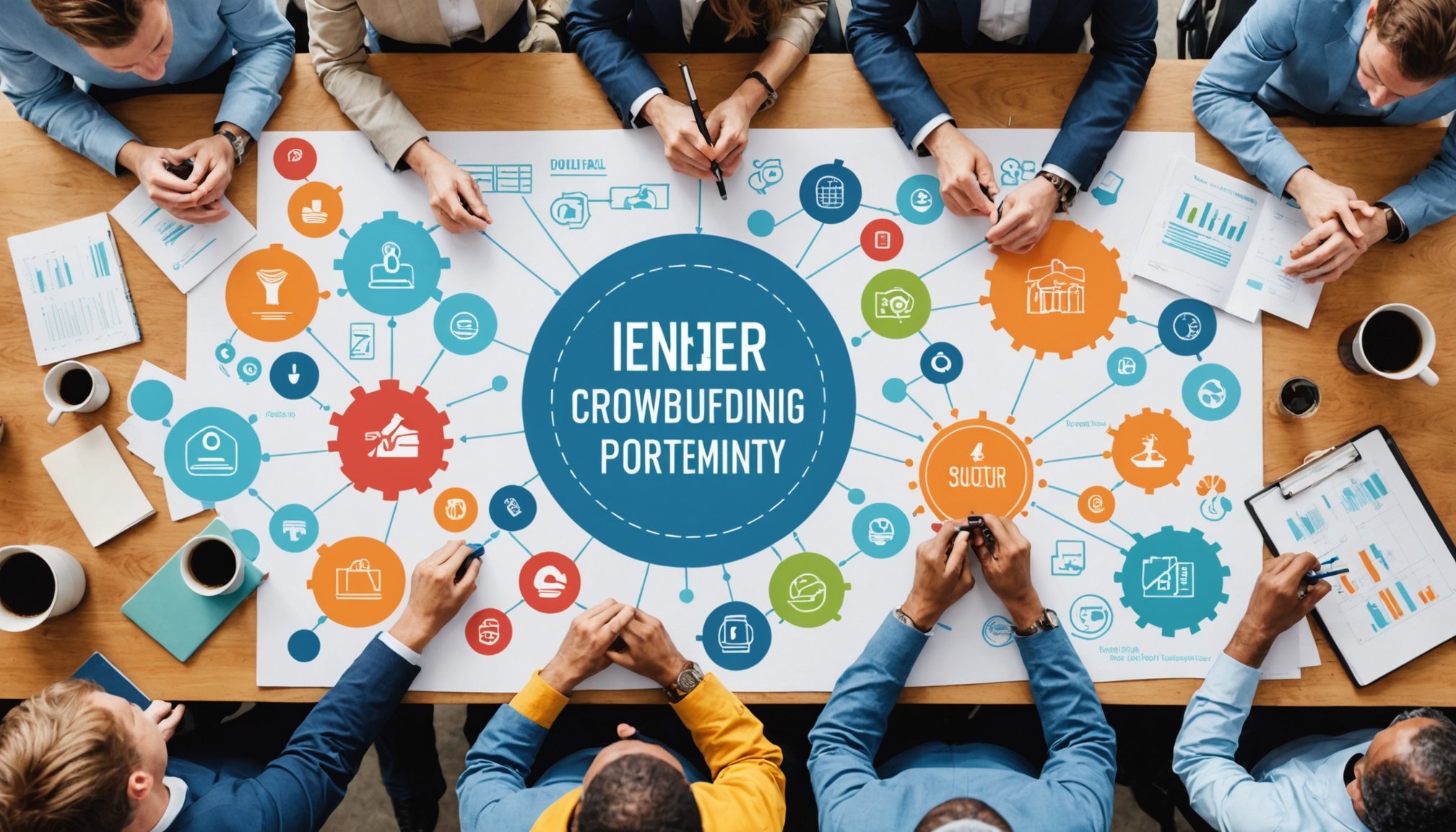Unlocking Potential: A Strategic Blueprint for UK Non-Profits to Master Crowdfunding Success
In the ever-evolving landscape of charity fundraising, crowdfunding has emerged as a powerful tool for UK non-profits to secure the funds they need to drive their missions forward. However, achieving crowdfunding success is not a mere coincidence; it requires a well-thought-out strategy, innovative approaches, and a deep understanding of the digital fundraising landscape. Here’s a comprehensive guide to help UK non-profits master crowdfunding and unlock their full potential.
Setting the Foundation: Understanding Crowdfunding
Before diving into the strategies, it’s essential to grasp the fundamentals of crowdfunding. Crowdfunding is a method of raising funds by collecting small amounts of money from a large number of people, typically through online platforms. For non-profits, this can be a game-changer, allowing them to reach a broader audience and build a community of supporters.
This might interest you : Maximizing workplace safety with custom equipment and signage
Key Benefits of Crowdfunding for Non-Profits
- Broader Reach: Crowdfunding platforms like Classy, GoFundMe, and Kickstarter enable non-profits to reach a global audience, far beyond their local donor base[5].
- Community Engagement: Crowdfunding campaigns often involve storytelling and updates, fostering a sense of community and engagement among donors[2].
- Flexibility: Crowdfunding can be used for various types of projects, from capital campaigns to specific programs or events[5].
Developing a Comprehensive Crowdfunding Strategy
A successful crowdfunding campaign is rooted in a clear, well-planned strategy. Here are the essential steps to develop such a strategy:
Setting SMART Goals
Setting Specific, Measurable, Achievable, Relevant, and Time-bound (SMART) goals is crucial for any fundraising campaign, including crowdfunding. These goals should align with the broader mission and vision of your organization.
Also to read : Revolutionizing education: embracing ar/vr innovations in uk schools and colleges
- Example Goals:
- Raise £20,000 for a new community center within the next 6 months.
- Increase the number of monthly recurring donors by 30% over the next year.
- Achieve a 25% increase in donations from new supporters through the crowdfunding campaign[1].
Diversifying Your Revenue Streams
While crowdfunding is a powerful tool, it should not be the only revenue stream for your non-profit. Diversifying your fundraising efforts reduces risk and ensures long-term sustainability.
- Revenue Streams to Consider:
- Individual Giving: Focus on recurring donations, major gifts, and legacy giving.
- Trust and Foundation Grants: Apply for grants from trusts and foundations that align with your mission.
- Corporate Partnerships: Develop relationships with local businesses or corporations with CSR programs.
- Fundraising Events: Host community-focused events like galas, fun runs, or silent auctions.
- Digital Fundraising: Leverage social media campaigns, email marketing, and online giving platforms[1].
Choosing the Right Crowdfunding Platform
The choice of crowdfunding platform can significantly impact the success of your campaign. Here are some key platforms and their features:
Comparison of Crowdfunding Platforms
| Platform | Key Features | Fees | Success Rate |
|---|---|---|---|
| Classy | Customizable, conversion-optimized campaigns; social proof; progress tracking | 2.9% + 0.30¢ | 20% conversion rate[5] |
| GoFundMe | Easy setup; social media integration; donor management tools | 2.9% + 0.30¢ | Raised $5 billion since 2015[2] |
| Kickstarter | All-or-nothing funding model; strong community support | 5% of funds raised | 41.7% success rate[5] |
| Fundable | Focus on business and product crowdfunding; flexible funding models | 3.5% + payment processing fees | 23.9% overall success rate[5] |
Selecting the Best Platform for Your Needs
When choosing a platform, consider the following factors:
- User Experience: Ensure the platform offers a seamless and intuitive donor experience.
- Fees: Understand the fee structure to maximize your fundraising potential.
- Customization: Opt for platforms that allow you to customize your campaign to align with your brand and mission.
- Success Stories: Look at the success rates and case studies of other non-profits on the platform[5].
Building a Compelling Crowdfunding Campaign
A successful crowdfunding campaign is built around a compelling story and a clear call to action.
Crafting Your Story
- Personal Stories: Use stories from the people most affected by your cause to create an emotional connection with donors[2].
- Visuals: Incorporate high-quality images and videos to illustrate the impact of donations.
- Clear Goals: Clearly state what the funds will be used for and how they will make a difference.
Creating an Engaging Campaign Page
- Greeting and Branding: Welcome new supporters with your brand and a relatable story.
- Impact of Donations: Show the specific impact of each donation (e.g., “$50 feeds three families this month”).
- Call to Action: Include a clear and prominent call-to-action button.
- Payment Options: Offer trusted payment methods like credit cards, PayPal, and Venmo[5].
Leveraging Digital Fundraising Tools
Digital fundraising tools are essential for amplifying your crowdfunding campaign.
Social Media Campaigns
- Platforms: Use platforms like Facebook, Instagram, and Twitter to raise awareness and reach new supporters.
- Content: Share updates, stories, and visuals regularly to keep your audience engaged.
- Influencers: Collaborate with social media influencers who align with your mission to expand your reach[2].
Email Marketing
- Segmentation: Segment your email list to tailor messages to different groups of supporters.
- Personalization: Personalize emails to make donors feel valued and connected to the cause.
- Follow-Up: Send follow-up emails to update donors on the campaign’s progress and express gratitude for their support[1].
Building Strong Donor Relationships
Donor relationships are the backbone of any successful fundraising campaign.
Peer-to-Peer Fundraising
- Empower Supporters: Encourage your supporters to raise funds among their friends and peers.
- Personalized Pages: Provide unique webpages for each supporter to share on their personal accounts.
- Recognition: Recognize and reward top fundraisers to motivate others[2].
Direct Mail and Traditional Fundraising
- Targeted Campaigns: Use direct mail to target established donors who prefer a tangible connection.
- Recurring Giving: Offer recurring giving options to retain donors at a higher rate (up to 90% retention for recurring donors)[2].
Reviewing and Refining Your Strategy
No fundraising strategy is static; it needs to evolve based on performance and feedback.
Regular Reviews
- Campaign Performance: Analyze the results of your crowdfunding campaign to identify what worked and what didn’t.
- Stakeholder Feedback: Gather feedback from donors, volunteers, and other stakeholders to refine your strategy.
- Adaptation: Be willing to adapt your strategy based on the insights gained from reviews and feedback[1].
The Future of Crowdfunding: Trends and Innovations
The future of crowdfunding is marked by several key trends that UK non-profits need to be aware of.
Transparency and Trust
- Direct Impact: Platforms like Beam and Kiva connect donors with beneficiaries, showing direct, tangible outcomes and building trust[4].
- Storytelling: Use compelling narratives to convey the impact of donations and foster a sense of community[4].
Innovation and Collaboration
- New Models: Embrace new funding models and innovative approaches to fundraising, such as peer-to-peer and crowdfunding campaigns.
- Collaborations: Collaborate with other non-profits and businesses to maximize resources and present unified campaigns with greater impact[4].
Balancing Short-Term Needs with Long-Term Strategies
- Immediate Needs: Address pressing short-term financial needs while also focusing on long-term sustainability.
- Calculated Risks: Take calculated risks to innovate and experiment, as this is essential for long-term growth[4].
Practical Insights and Actionable Advice
Here are some practical tips and advice to help you master crowdfunding:
Tips for a Successful Crowdfunding Campaign
- Start Early: Begin promoting your campaign well before the launch date to build anticipation.
- Engage Your Community: Keep your supporters updated and engaged throughout the campaign.
- Show Gratitude: Express sincere gratitude to donors and recognize their contributions publicly.
- Leverage Social Proof: Use testimonials and success stories to build credibility and trust.
Example of a Successful Crowdfunding Campaign
- Atlanta Habitat for Humanity: Used Classy to exceed a $100,000 goal with a single crowdfunding campaign, achieving an average donation of $670[5].
Mastering crowdfunding is not just about raising funds; it’s about building a community, fostering trust, and creating a sustainable business model for your non-profit. By setting clear goals, choosing the right platform, crafting a compelling story, leveraging digital tools, and continuously refining your strategy, you can unlock the full potential of crowdfunding.
As Alex Day from Big Give notes, “The decline in public confidence in large institutions is pushing the sector toward more direct, peer-to-peer fundraising models that promote transparency.” By embracing innovation, fostering trust, and aligning closely with social causes, UK non-profits can thrive in the evolving fundraising landscape[4].
In the words of Christina Anderson from GoFundMe, “Charities will need to embrace new models, build trust through greater transparency, and align closely with the social causes prioritised by younger generations.” By following this strategic blueprint, you can ensure that your charity not only survives but thrives in the future of fundraising[4].











